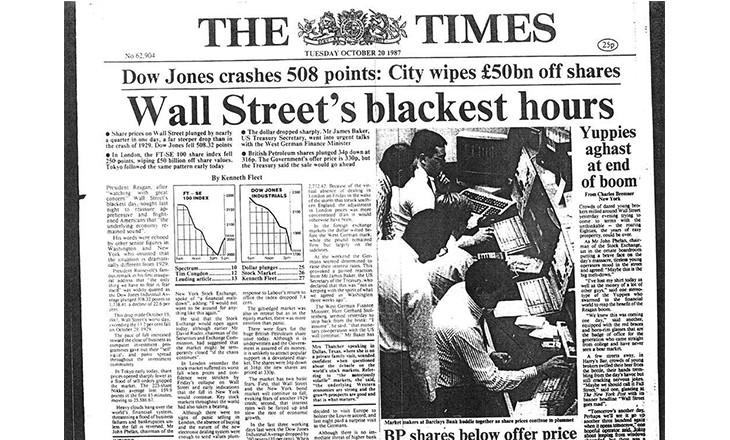Lessons From 29 Years of Market History
29 years ago this month the world equity markets experienced a meltdown that became known as Black Monday (or Black Tuesday in Asian time zones). On October 19, the Dow Jones Industrial Average plunged 23%, which happened to be its largest-ever one-day percentage decline.
As equity and bond markets fell, an anonymous bond trader sensed an opportunity. He sold a U.S. long bond (a 30-year Treasury bond yielding 8.875% and maturing in 2017) at a price of 86. Just two months earlier, the bond had been issued at par. The trader was hoping to buy it back a quarter of a point lower.
Yet a minute later the bond market reversed direction and has not looked back since.
There’s a famous Wall Street saying stating that The market always gives you a second chance. In this case, there was none. Long bond yields fell by 60 basis points (bps) from that moment to end the day at 9.80% – and yields would keep falling for 29 more years, reaching a record low of 2.1% last July.
Investors who felt they had missed the move that day and decided to sit it out would not only have foregone a generous yield of 10% but also massive capital appreciation. That bond peaked in price at 158 in 2003 – and then only because it started suffering from the old age phenomenon dubbed “pull to par” (all Treasury bonds mature at par).
Some key lessons from this history:
- It is incredibly important to focus on secular trends and potentially detrimental to trade on short-term price action, even more so at important turning points in financial markets.
- Using bonds to protect against equity market losses is neither a new fad nor a result of quantitative easing policies, which were not implemented in the aftermath of Black Monday. (However, there may well come a time when the negative correlation between stocks and bonds becomes less stable, and even flirts with positive territory – e.g., when deflation fighting turns into inflation fighting. That’s one of several reasons for actively managing portfolios across asset classes.)
- It is instructive that faced with a momentous event like the 1987 stock market crash, the Federal Reserve eased policy by only around 100 bps. It left the heavy lifting to the bond market, which rallied 200 bps, and the foreign exchange market, which pushed the dollar down by about 10%. Contrast that with today’s policy and market environment where most of the work seems to be done directly or indirectly by the central banks.
